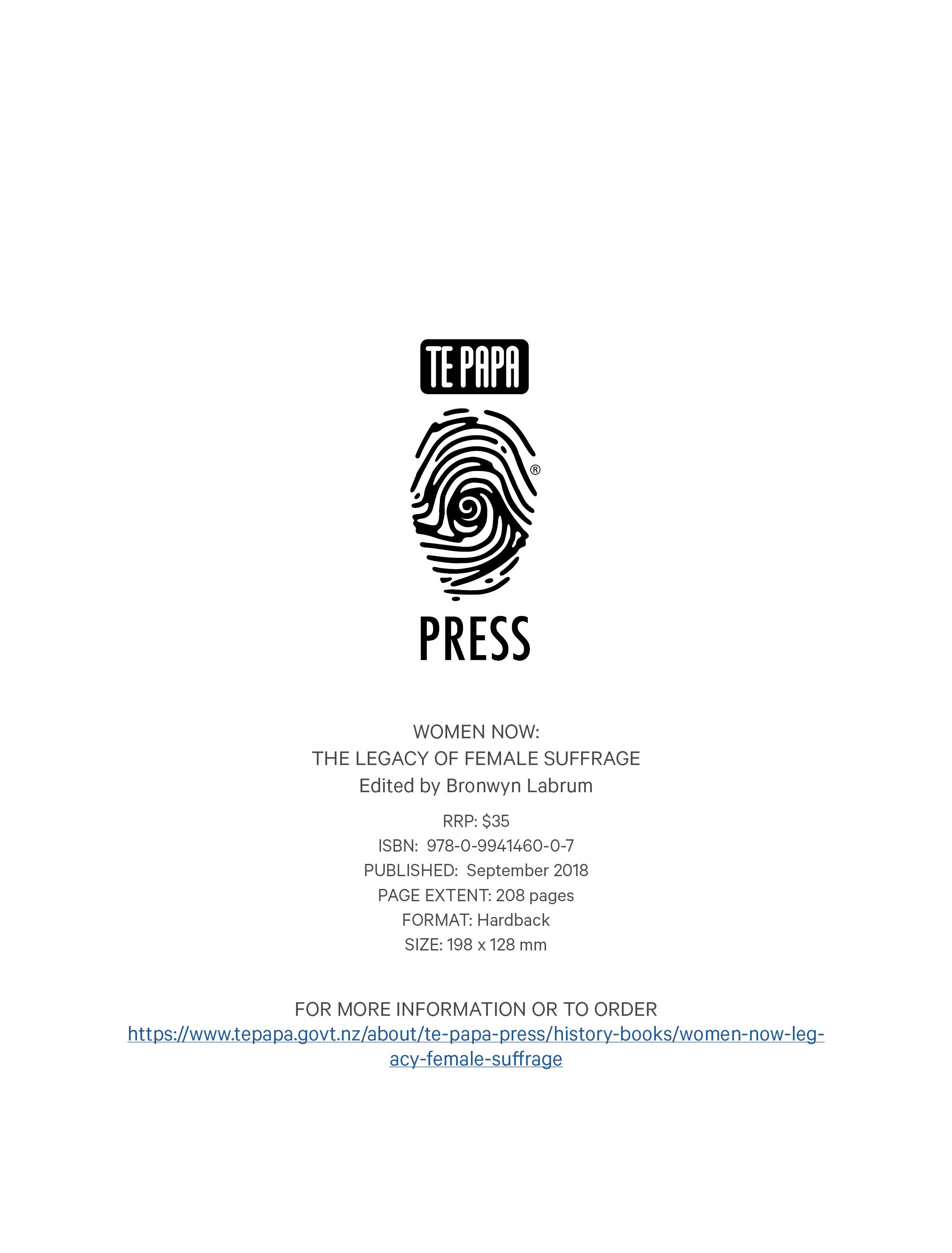






INTRODUCTION / 7
Bronwyn Labrum
THE POWER OF THE WORD / 21
Barbara Brookes
LIVES ON THE LINE / 37
Sue Bradford
OUR COUNTRY’S MIRROR / 51
Morgan Godfery
UNFINISHED BUSINESS / 65
Sandra Coney
PLAYING WITH FIRE / 81
Fiona Kidman
WHAT WILL I TELL MY DAUGHTERS? / 95
Holly Walker
AT THE FOREFRONT / 109
Ben Schrader
LET’S FIX THIS / 125
Golriz Ghahraman

A simple pamphlet, a key way of communicating with adherents to a nineteenth-century national cause, raises a myriad of questions. Why was this pamphlet, written by Christchurch-based Kate Sheppard, printed in Invercargill? Did Sheppard telegraph or mail her copy to her southern printer? Did every printing house look kindly on women’s suffrage or were particular printers known to be well disposed to the women’s cause? Who designed it, with its six different fonts on the front and the elegant border? How many copies were printed and how many read? The survival of such fragile pamphlets — known in the library world as ephemera — prompts the reader to explore new avenues of historical research. If I had seen this in a second-hand bookshop, I would have scooped it up.
There is something about holding documents produced at the time I am researching that moves me — be they pamphlets, court records, casebooks or letters. It was that sense of being in touch with the past that led me to become a historian. I do have my own piece of suffrage ephemera, so precious to me that I had it specially framed to present both sides. I chose purple, green and white surrounds for the front image, since they were the suffrage colours. This piece of paper — a throwaway printedcard programme — is on the wall of my study and I often contemplated it while working on my History of New Zealand Women.
Given to me when I was a graduate student living in England in 1981, studying the then disreputable topic of backstreet abortion, the programme was issued for the public meeting to
commemorate the enfranchisement of women, held at the city hall in Cardiff, Wales, on 5 July 1918. My landlady (I lived in a bedsit in her house) was the daughter of an English suffragist and had become a doctor, since her mother believed that women should take up a profession. It was an unhappy choice for her — living out the dreams of her activist mother — but she loved my interest in women’s history, told me all sorts of fascinating things about her past, and found me people to talk to about their experiences of abortion. She gave me her mother’s carefully preserved programme. On one side is an illustration of a Joan of Arc-type figure holding a flag entitled ‘Woman’s Franchise’. Underneath the image are the words ‘AT LAST!’ and overwritten there is the signature, in pencil, of the leader of the constitutional suffragists, Millicent Garrett Fawcett. I treasure this gift from Silvia Mehta.
No doubt the New Zealand Women’s Christian Temperance Union issued many programmes of celebratory meetings when the suffrage was won, but I’ve never seen one. People often don’t keep such things and when they do, their descendants, for whom they are often meaningless, are quick to get rid of them. Fortunately a number of WCTU pamphlets survive, reprinting talks of note or advice they thought others might find useful. Their pamphlet on ‘Economic Cooking Lessons’, for example, reached its third edition by 1889. In her ‘Hints to District Franchise Superintendents’, published in the WCTU page of The Prohibitionist in February 1892, Kate Sheppard advised, ‘Keep as good a stock of franchise literature on hand as funds will allow; books to lend, if feasible, but certainly pamphlets,
leaflets, etc.’1 Pamphlets were freely distributed at places where people gathered, such as agricultural shows. Sheppard keenly followed events abroad and collected literature by overseas suffrage societies, reminding her readers they were part of an international movement. Educating the public about women’s suffrage was an urgent matter, and she believed in the power of the word to change minds.
There were many matters to be set to rights in the late 1890s: first and foremost, the drinking problem. Women witnessed the devastating impact of alcohol within their communities. Trouble brewed in public houses, where men might take their daily wages and could easily drink the money away, going home empty-handed. If women objected, violence might erupt. The number and rowdiness of public houses made the streets unsafe and accidents common. The rapid growth of the WCTU in New Zealand after the visit of Mary Leavitt, an American WCTU missionary who toured the world campaigning against alcohol in 1885, attests to the strength of feeling against the drink trade amongst middle-class women.
High rates of drunkenness were common in colonial societies, giving impetus to the fight against alcohol. But the American founder of WCTU, Frances Willard, urged women to ‘do everything’ since she believed all social problems to be interconnected. Kate Sheppard quickly recognised this when she assisted with a petition to Parliament arguing against the employment of barmaids. When it was ignored, she realised that women had to have the vote to effect change. As the head of the WCTU Franchise and Legislation Section from 1887,
